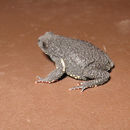Description
provided by AmphibiaWeb articles
Female: 22-28 mm, Male: 18-22 mm. Dorsum uniformly black without blotches. Belly black with red and/or yellow blotches. Interdigital web poorly developed. Throat dark. Sexual dimorphism is not evident. This species could be easily confused with Melanophryniscus montevidensis.
- Achaval, F., and Olmos, A. (2003). Anfibios y reptiles del Uruguay Ed. Graphis. Serie Fauna N°, Montevideo, Uruguay.
- Klappenbach, M. A., and Langone, J. A. (1992). ''Lista sistemática y sinonímica de los anfibios del Uruguay con comentarios y notas sobre su distribución.'' Anales del Museo Nacional de Historia Natural de Montevideo (2a Serie), 8, 163-222.
- Kwet, A., Maneyro, R., Zillikens, A., and Mebs, D. (2005). ''Advertisement calls of Melanophryniscus dorsalis (Mertens, 1933) and M. montevidensis (Philippi, 1902), two parapatric species from southern Brazil and Uruguay, with comments on morphological variation in the Melanophryniscus stelzneri group (Anura: Bufonidae).'' Salamandra, 41(1/2), 1-18.
- Kwet, A., and Miranda, T. (2001). ''Zur Biologie und Taxonomie der Swarzkrote Melanophryniscus atroluteus (Miranda-Ribeiro, 1920).'' Herpetofauna, 23, 19-27.
- Langone, J. A. (1994). Ranas y sapos del Uruguay (reconocimientos y aspectos biológicos). Museo Damaso Antonio Larrañaga 5, Serie de Divulgación
- Maneyro, R., Forni, F., and Santos, M. (1995). Anfibios del Departamento de Rocha. Serie Divulgación Técnica 1 (PROBIDES), Rocha, Uruguay.
- Maneyro, R., and Langone, J. A. (2001). ''Categorización de los anfibios del Uruguay.'' Cuadernos de Herpetología, 15(2), 107-118.
- Miranda-Ribeiro, A. (1920). ''Os Brachycephalideos do Museu Paulista (com tres especies novas).'' Revista do Museu Paulista, 12, 305-313.
- Núñez, D., Maneyro, R., Langone, J. A. and De Sá, R. O. (2004). ''Distribución geográfica de la fauna de anfibios del Uruguay.'' Smithsonian Herpetological Information Series, 134, 1-34.
Distribution and Habitat
provided by AmphibiaWeb articles
This species inhabits grasslands, open savannas and some areas with rocky soils. Widespread in Pampas grasslands (South America).
Life History, Abundance, Activity, and Special Behaviors
provided by AmphibiaWeb articles
These diurnal toads are active throughout the year and they are explosive breeders. They reproduce in temporary ponds, following heavy rains. The advertisements calls have two components: a repeated whistle, followed by a train of vibrations. During amplexus females release about one hundred eggs in several immersion events. This species exhibits a defensive behaviour ("Unkenreflex").
Life History, Abundance, Activity, and Special Behaviors
provided by AmphibiaWeb articles
M. atroluteus is a common species in Uruguay in habitats with extensive cattle raising. Intensive livestock could affect reproductive habitat quality (i.e. hard soils - compactation).
Melanophryniscus atroluteus
provided by wikipedia EN
Melanophryniscus atroluteus is a species of toad in the family Bufonidae. It is found in northeastern Argentina, Uruguay, southern Paraguay, and southern Brazil (Rio Grande do Sul, presumably also Santa Catarina).[1][2] While in the past it was considered a subspecies of Melanophryniscus stelzneri, it might rather be conspecific with Melanophryniscus montevidensis.[2] Common name Uruguay redbelly toad (also spelled Uruguay red belly toad) has been coined for it.[1][2]
Description
Males can reach 25 mm (1.0 in) and females 29 mm (1.1 in) in snout–vent length,[3] although reported lengths are commonly slightly smaller.[3][4] Skin is strongly granular.[3] The dorsum is uniformly black, without blotches, while the belly is black and has red and/or yellow blotches. The throat is dark. Webbing is poorly developed.[4]
Behavior
When threatened, this species exhibits the Unkenreflex behavior.[4]
Habitat and conservation
Melanophryniscus atroluteus occurs in grasslands at elevations up to 1,200 m (3,900 ft). Breeding is explosive and takes place in temporary pools and agricultural ditches.[1]
In parts of its range (Argentina and Uruguay,), M. atroluteus is abundant during the breeding, but it is rare or uncommon elsewhere. It can occur in substantially disturbed habitats, but not in areas with intensive cattle activities. It is threatened by pine and Eucalyptus plantations and by drainage of wetlands. Pet trade might also become a threat. It does not appear to occur in any larger protected areas.[1]
References
-
^ a b c d e Axel Kwet, Lucy Aquino, Jose Langone, Diego Baldo, Raúl Maneyro (2010). "Melanophryniscus atroluteus". IUCN Red List of Threatened Species. 2010: e.T54816A11207899. doi:10.2305/IUCN.UK.2010-2.RLTS.T54816A11207899.en. Retrieved 15 November 2021.
{{cite journal}}: CS1 maint: multiple names: authors list (link) -
^ a b c d Frost, Darrel R. (2019). "Melanophryniscus atroluteus (Miranda-Ribeiro, 1920)". Amphibian Species of the World: an Online Reference. Version 6.0. American Museum of Natural History. Retrieved 10 July 2019.
-
^ a b c Kwet, A. & Miranda, T. (2001). "Zur Biologie und Taxonomie der Schwartz-kröte Melanophryniscus atroluteus (Miranda-Ribeiro, 1920)". Herpetofauna (in German). 23: 19–27.
-
^ a b c "Melanophryniscus atroluteus". AmphibiaWeb. University of California, Berkeley. 2006. Retrieved 10 July 2019.

- license
- cc-by-sa-3.0
- copyright
- Wikipedia authors and editors
Melanophryniscus atroluteus: Brief Summary
provided by wikipedia EN
Melanophryniscus atroluteus is a species of toad in the family Bufonidae. It is found in northeastern Argentina, Uruguay, southern Paraguay, and southern Brazil (Rio Grande do Sul, presumably also Santa Catarina). While in the past it was considered a subspecies of Melanophryniscus stelzneri, it might rather be conspecific with Melanophryniscus montevidensis. Common name Uruguay redbelly toad (also spelled Uruguay red belly toad) has been coined for it.
- license
- cc-by-sa-3.0
- copyright
- Wikipedia authors and editors

